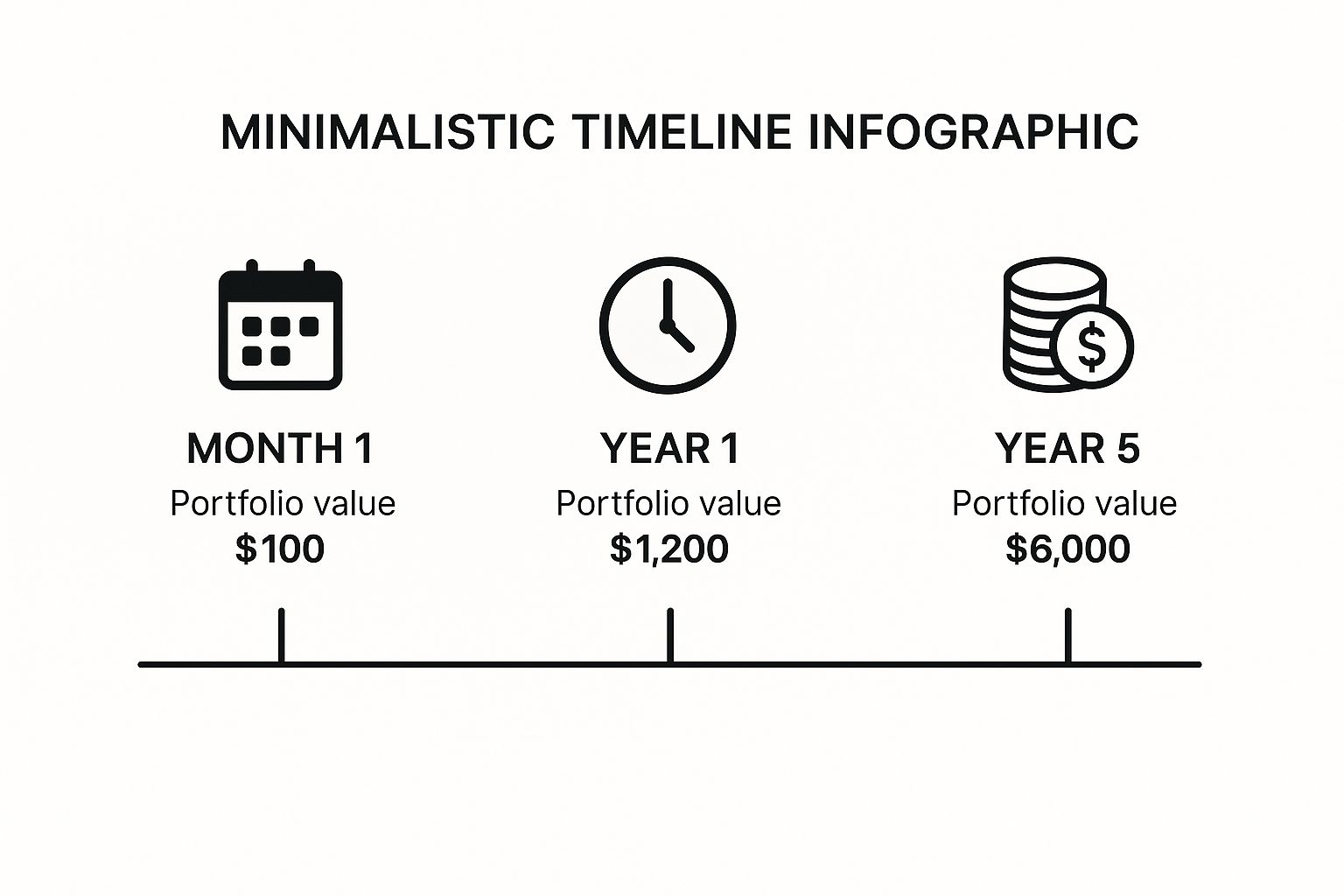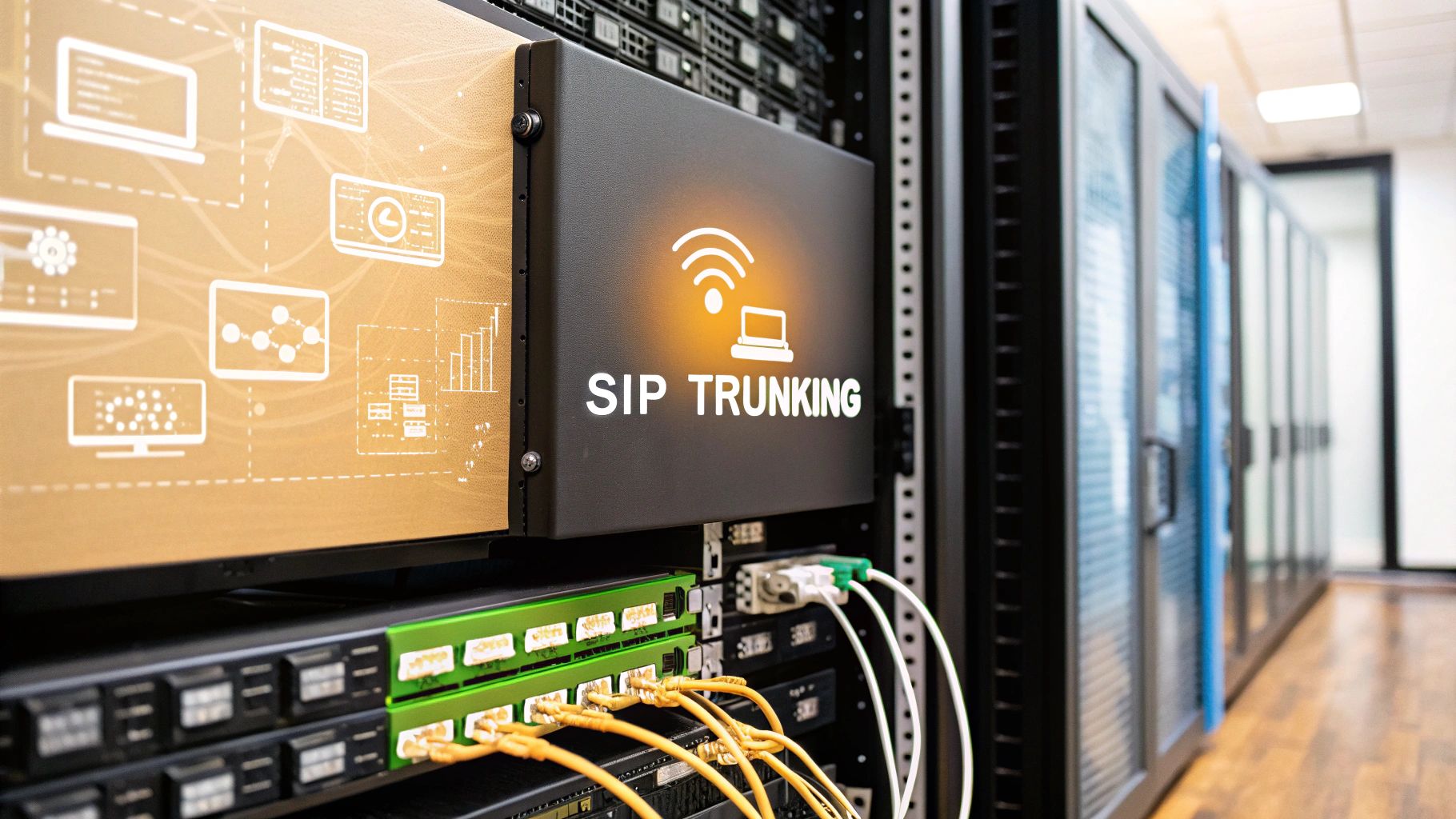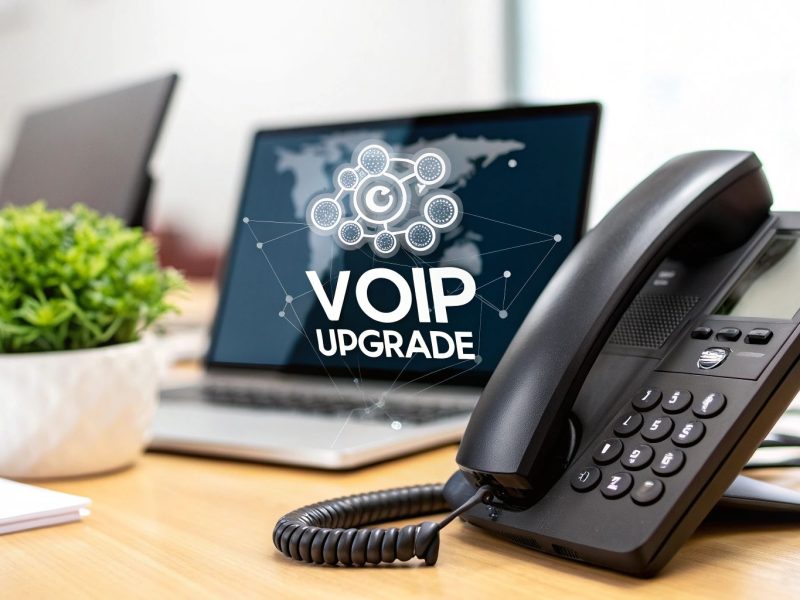Understanding What Is SIP – The Foundation You Need

SIP (Session Initiation Protocol) is the backbone of modern business communication. Simply put, it's a set of rules that dictates how communication devices connect and interact over the internet. It's the language that allows your systems to communicate, much like how web browsers communicate with websites. This means voice, video, and messaging services can operate through a single internet connection, replacing traditional phone lines.
How SIP Trunking Works in Simple Terms
SIP trunking replaces traditional phone lines with a digital connection. It's like a virtual cable connecting your phone system to the internet. This connection facilitates calls, video conferences, and instant messages all through your existing broadband. This consolidation simplifies infrastructure and often leads to significant cost savings by merging voice and data onto one network.
Core Components of SIP Trunking
Effective SIP trunking depends on several key components. A SIP provider supplies the virtual connection to the public telephone network. A SIP-enabled PBX (Private Branch Exchange), either physical or cloud-hosted, manages your communications. Call routing automation ensures efficient call direction, and system integration links communications with other business applications like CRM software. Planning a SIP strategy requires careful consideration, similar to choosing the right keywords for a marketing campaign. Just as excluding irrelevant terms is vital, understanding concepts like negative keywords can be beneficial for refining your approach.
Real-World Examples of SIP in Action
Businesses across various sectors are using SIP trunking to improve their communications. A retail chain with multiple locations can connect all branches on a single network, enabling free inter-office calling and centralized customer service. Startups can scale their phone systems instantly to match their needs without significant infrastructure investment. Hospitals can integrate SIP with their systems, improving patient care by giving doctors direct access to patient information during calls. These examples showcase the flexibility and efficiency gains SIP trunking provides.
Why Middle East And Africa Businesses Are Making The Switch

The telecommunications industry across the Middle East and Africa is evolving. Businesses are moving away from traditional phone systems and embracing Session Initiation Protocol (SIP)-based solutions. This shift reflects a growing need for adaptable and cost-effective communication strategies.
Digital Transformation and Cost Efficiency
Many businesses in the region are undergoing digital transformation. SIP trunking supports these initiatives by integrating voice, video, and messaging onto a single platform. This unified approach simplifies communications and streamlines workflows.
Cost pressures also contribute to SIP adoption. Converging voice and data onto one internet connection significantly reduces telecom expenses. This consolidation leads to more efficient resource allocation and improves the bottom line. For more information on SIP trunking, check out this resource: How to master…
Enhanced Infrastructure and Regional Benefits
Improved internet infrastructure across the Middle East and Africa is another factor driving SIP adoption. Increased bandwidth and better network reliability make SIP trunking a practical solution for businesses of all sizes.
SIP trunking offers unique advantages in this region. It helps businesses overcome communication challenges, enhance operational efficiency, and thrive in a competitive global market. This growth is reflected in market projections, with the Middle East and Africa SIP Trunking Services market anticipated to reach USD 1,551.30 million by 2029, expanding at a CAGR of 10.3% between 2022 and 2029. For further market analysis, see: Middle East and Africa SIP Trunking Services Market
Practical Applications Across Diverse Industries
Businesses across various sectors are already benefiting from SIP trunking. Financial institutions utilize SIP for secure communication and improved customer service.
Healthcare providers leverage SIP to facilitate communication among doctors, patients, and administrative staff. Logistics companies utilize SIP to enhance coordination and streamline their supply chains.
These examples showcase the versatility and adaptability of SIP trunking in diverse operational settings. They demonstrate the practical benefits of transitioning to a modern, SIP-based communication system.
The Game-Changing Benefits That Matter Most

Cost savings are only the starting point when discussing SIP trunking. This technology presents a wealth of advantages that can reshape how businesses across the Middle East and Africa operate and connect.
Scalability and Flexibility for Modern Businesses
One of the most significant benefits is scalability. Adding or removing lines with SIP trunking is a streamlined process. This empowers businesses to readily adapt to evolving needs, such as seasonal call volume spikes or company growth. Gone are the days of protracted installations and complex hardware adjustments.
SIP trunking also provides remarkable location flexibility. Employees can work remotely, from anywhere with reliable internet access, and still maintain the same professional communication standards they would have in a traditional office setting. This is particularly valuable in our current business landscape, with its increasing emphasis on remote work.
Enhanced Features and Business Continuity
Beyond flexibility, SIP trunking delivers enhanced call quality compared to traditional landlines. This improved clarity contributes to more effective communication with both customers and colleagues.
Moreover, advanced features like unified messaging, which integrates voicemail, email, and fax into a single platform, are often standard with SIP trunking services. This consolidation streamlines communication workflows and enhances overall productivity.
Disaster recovery planning is also significantly improved with SIP trunking. In the event of an outage at your primary location, calls can be automatically rerouted to an alternate site. This ensures business continuity during unforeseen disruptions, minimizing downtime and protecting against potential revenue loss.
To better illustrate the differences, let's look at a detailed comparison between SIP trunking and traditional phone systems.
The following table, "SIP Trunking vs Traditional Phone Systems Comparison," outlines the key differences in cost, scalability, and features between the two systems. It helps to visualize the advantages SIP trunking offers in a direct comparison.
| Feature | SIP Trunking | Traditional Phone System | Advantage |
|---|---|---|---|
| Cost | Lower monthly fees | Higher monthly fees | SIP Trunking |
| Scalability | Easy to add/remove lines | Requires physical installation | SIP Trunking |
| Location Flexibility | Works from anywhere with internet | Tied to physical location | SIP Trunking |
| Call Quality | Enhanced clarity | Can be susceptible to interference | SIP Trunking |
| Features | Unified messaging, advanced call routing | Limited features | SIP Trunking |
| Disaster Recovery | Automatic rerouting | Can be complex to implement | SIP Trunking |
| Maintenance | Simplified management | Requires on-site maintenance | SIP Trunking |
As the table clearly demonstrates, SIP trunking holds a considerable advantage in terms of cost-effectiveness, adaptability, and advanced features, making it a powerful solution for modern businesses.
Real-World Examples of SIP Benefits
Consider a fast-growing e-commerce business in Dubai. During peak seasons, they can easily scale their phone system to accommodate the surge in customer calls. Or a consulting firm with employees spread across the UAE; they can utilize SIP trunking to maintain seamless communication through a unified platform, no matter where their employees are located. A hospital in Riyadh could leverage SIP trunking for reliable emergency communication, ensuring uninterrupted service during unforeseen circumstances. These practical examples demonstrate the versatility of SIP trunking in addressing diverse business communication needs.
Choosing The Right SIP Deployment For Your Business
Selecting the right SIP deployment is a critical decision for any business looking to optimize its communication strategy. Your choice directly impacts cost, control, and maintenance, all of which play a crucial role in the overall success of your communications. There are three primary deployment models to consider: on-premise, cloud-based, and hybrid. Understanding the strengths and weaknesses of each model is essential for making an informed decision.
On-Premise SIP Deployment
With an on-premise SIP solution, you host the entire system within your own infrastructure. This provides maximum control over security and allows for extensive customization. Large enterprises often favor this approach because it gives them direct management of their communication systems. This is particularly common in the Middle East and Africa, where large organizations prioritize this level of control. Explore this topic further The flexibility of on-premise solutions allows companies to tailor the system precisely to their specific requirements.
However, on-premise solutions come with higher upfront costs and ongoing maintenance responsibilities. You will need dedicated IT staff to manage the system, ensuring its smooth operation and addressing any technical issues that may arise.
Cloud-Based SIP Deployment
Cloud-based SIP, often referred to as hosted SIP, relies on a third-party provider to manage the infrastructure. This eliminates the need for investing in expensive hardware and significantly reduces IT overhead. Cloud solutions offer inherent flexibility and scalability, making them an attractive option for smaller businesses. By shifting the maintenance burden to the provider, cloud-based SIP simplifies management and frees up internal resources.
However, opting for a cloud deployment means relinquishing some control over your system. Security considerations become dependent on the provider's infrastructure and their data protection policies, requiring careful vetting of potential partners.
Hybrid SIP Deployment
A hybrid SIP deployment combines elements of both on-premise and cloud-based solutions. This approach allows businesses to retain control over critical components while leveraging the flexibility of cloud services for specific functionalities. For example, you might choose to host your core PBX on-site while using a cloud provider for features like call routing or disaster recovery. You might be interested in: Etisalat SIP Trunk
Hybrid solutions offer a balanced approach, empowering organizations to tailor their deployment to their unique needs. This allows businesses to customize their system while minimizing costs and maintenance efforts.
Choosing the right SIP deployment is a fundamental decision that significantly impacts your communication system’s effectiveness. Carefully evaluate your organization's size, technical capabilities, and budget to determine the optimal solution. These considerations are particularly relevant in the Middle East and Africa, where connectivity and infrastructure factors often influence the final decision.
Implementation That Actually Works (Without The Headaches)

This infographic visualizes portfolio growth potential over five years, from $100 to $6,000. This projection, while investment-specific, highlights the power of strategic planning, a critical element for successful SIP implementation. A well-defined plan is essential to unlocking your SIP trunking solution's full value.
Assessing Your Current Infrastructure
Before transitioning to SIP trunking, a comprehensive assessment of your existing infrastructure is paramount. This involves evaluating your current phone system, network capacity, and internet connection. This assessment establishes a baseline understanding of your needs and identifies potential roadblocks.
For example, inadequate bandwidth can significantly impact call quality, underscoring the importance of accurate bandwidth calculations. Understanding your current setup allows you to plan for a smooth and efficient migration.
Bandwidth and Network Security
Precise bandwidth calculations are vital for seamless voice and video communication. Factor in the expected number of concurrent calls, the data demands of other network applications, and future growth projections. This ensures your network can manage the increased SIP trunking traffic without performance degradation.
Network security is equally critical. Implementing robust security measures like firewalls) and encryption protocols safeguards your communications against potential threats. Protecting your data and communications is a non-negotiable aspect of SIP implementation.
Testing and Training
Thorough testing is indispensable before full SIP trunking deployment. This proactive approach allows you to identify and resolve technical problems before they affect business operations. Simulated calls, scenario testing, and system integration verification ensure a smooth transition.
Staff training on the new system is also essential. Comprehensive training materials, hands-on sessions, and ongoing support facilitate user adoption and maximize your SIP investment. A well-trained team ensures efficient utilization of the new system.
Migration Timeline and Avoiding Pitfalls
A detailed migration timeline keeps your implementation on schedule. It outlines key milestones, defines roles and responsibilities, and provides a clear roadmap. A phased rollout, for example, might involve migrating a small initial user group, followed by a larger group, allowing you to address any early issues. This measured approach minimizes disruption and allows for continuous improvement.
To help visualize the implementation process, we've provided a detailed timeline below:
SIP Implementation Timeline and Milestones
A structured timeline showing key phases, duration estimates, and critical checkpoints for successful SIP trunking deployment.
| Phase | Duration | Key Activities | Success Metrics |
|---|---|---|---|
| Infrastructure Assessment | 1-2 Weeks | Evaluate existing phone system, network capacity, and internet connection. Identify potential bottlenecks. | Complete infrastructure documentation. Gap analysis report. |
| Bandwidth Calculation & Security Implementation | 1 Week | Determine required bandwidth. Implement firewalls and encryption protocols. | Confirmed bandwidth capacity. Security audit completion. |
| System Setup and Configuration | 2-4 Weeks | Install and configure SIP trunking equipment. Integrate with existing phone system. | Successful system integration test. |
| Testing and User Training | 1-2 Weeks | Conduct simulated calls and test different scenarios. Train staff on new system usage. | Test case pass rate of 95% or higher. User proficiency demonstrated through training assessments. |
| Phased Rollout and Go-Live | 2-4 Weeks | Migrate users in phases. Monitor system performance and address any issues. | Successful migration of all users. System stability and performance meeting pre-defined criteria. |
| Post-Implementation Monitoring and Optimization | Ongoing | Monitor system performance, gather user feedback, and optimize configurations. | Consistent call quality and system uptime. Positive user feedback and satisfaction scores. |
This table provides a framework for managing your SIP implementation. Each phase is crucial for overall success, and careful monitoring ensures a smooth transition.
Real-World Implementations
Consider a UAE healthcare business needing constant communication. A carefully planned implementation ensures a seamless transition to SIP without disrupting patient care. A retail business with multiple Middle Eastern locations might prioritize a staged implementation, maintaining smooth connectivity at each branch without interrupting daily operations. These examples highlight the importance of tailoring your implementation strategy to specific business needs. Successfully navigating the intricacies of what is SIP implementation empowers businesses to harness its full power.
Real Cost Analysis and Return on Investment
Understanding the financial impact of SIP trunking requires a thorough cost analysis. It's essential to look beyond the initial setup fees and consider the broader financial picture. This includes evaluating both the immediate cost savings and the long-term return on investment.
Direct Cost Savings With SIP
SIP trunking presents several opportunities for direct cost reduction. One major advantage is significantly lower phone bills. Calls, especially international calls, are often much cheaper using SIP. Additionally, eliminating traditional phone lines removes the costs associated with maintaining physical hardware. This translates to fewer maintenance visits and lower operating expenses. For example, a company with multiple branches could consolidate communications onto a single SIP trunk, significantly reducing inter-office call costs.
Indirect Benefits and Productivity Gains
Beyond direct cost savings, SIP trunking offers indirect benefits that contribute to a healthier bottom line. Improved productivity is one key advantage. Features like Unified Communications and presence information can streamline workflows and enhance team collaboration. When implementing SIP, healthcare interoperability is essential for seamless communication across different systems. For more on this topic, see Top Healthcare Interoperability Solutions for 2025. Furthermore, the enhanced reliability and failover capabilities of SIP lead to reduced downtime, contributing to increased productivity and potentially higher revenue.
Calculating ROI and Payback Periods
Calculating the return on investment (ROI) for SIP trunking involves comparing the total cost of implementation and ongoing service fees with the projected cost savings and productivity gains. While typical payback periods can vary between industries, many businesses realize a return on their SIP investment within 12-18 months. Long-term savings projections can further substantiate the initial investment, showcasing the financial viability of SIP trunking.
Hidden Costs and Contract Negotiation
It's crucial to be mindful of potential hidden costs during implementation. These can include setup fees, porting charges, and integration expenses. Careful contract negotiation is paramount to safeguarding your interests and ensuring a clear understanding of all costs involved. Negotiating favorable service level agreements (SLAs) and ensuring flexibility for future growth are key aspects of this process. A well-structured contract can help mitigate unexpected financial surprises.
Budgeting for Growth and Long-Term Planning
When budgeting for SIP trunking, consider future growth projections. A scalable SIP solution allows you to easily add or remove lines as needed, eliminating the need for costly infrastructure upgrades. This adaptability ensures your communication system can keep pace with your evolving business requirements. By factoring scalability into your budget, you can avoid unforeseen expenses in the future. This proactive approach is essential for long-term business success.
Getting Started With Your SIP Journey
Ready to embrace SIP trunking? This section offers a practical guide for implementing a successful SIP solution. We'll delve into current trends, explore integration possibilities, and discuss how SIP can contribute to broader digital transformation initiatives. This knowledge will empower you to strategically position your communication infrastructure for both immediate needs and future expansion.
Evaluating SIP Providers
Choosing the right SIP provider is paramount for a successful implementation. Begin by clearly defining your specific requirements. This includes anticipated call volume, essential features (such as video conferencing and unified messaging), and any required integrations with existing systems. For further insights, explore our article on small business phone systems and VoIP. Also, carefully consider factors like service reliability, the quality of customer support, and the robustness of security protocols when making your decision. A thorough comparison of providers based on these criteria ensures a suitable fit for your unique business needs.
Vendor Selection Guidelines
Selecting a vendor goes beyond simply comparing prices. Look for vendors with a proven track record of successful SIP deployments, particularly within the AE region. Seek out testimonials and case studies from businesses similar to yours. For instance, if you operate in a regulated industry like healthcare or finance, prioritize vendors familiar with relevant local compliance regulations. A vendor's experience and understanding of your specific industry can significantly influence the success of your implementation.
Preparing For Implementation
Meticulous preparation is essential for a seamless transition to SIP trunking. Assess your existing network infrastructure to ensure it can handle the increased demands of SIP. This includes evaluating your internet bandwidth and reviewing your firewall configuration. Additionally, plan for comprehensive user training to empower your team to effectively utilize the new system. Adequate preparation minimizes potential disruptions and maximizes the return on your investment.
Future-Proofing Your Communications
SIP trunking provides a flexible foundation for future communication needs. Explore potential integration opportunities with other business tools, such as CRM systems and collaboration platforms. Integrating SIP with your CRM, for example, can enhance customer service by providing agents with immediate access to customer information during calls. By thinking strategically and selecting a scalable solution, you can ensure your communication system adapts to your evolving business requirements.
Ready to modernize your business communications? Visit Cloud Move to explore our SIP solutions and request a free demo. We can help you optimize your communication strategy for improved efficiency and sustainable growth.




